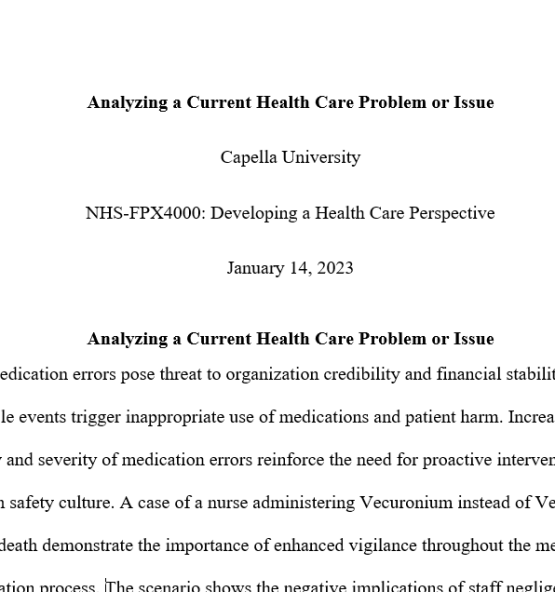
Analyzing a Current Health Care Problem or Issue
Capella University
NHS-FPX4000: Developing a Health Care Perspective
January 14, 2023
Availability:In Stock
Medication errors pose threat to organization credibility and financial stability. The preventable events trigger inappropriate use of medications and patient harm. Increased frequency and severity of medication errors reinforce the need for proactive interventions to strengthen safety culture. A case of a nurse administering Vecuronium instead of Versed and the resulting death demonstrate the importance of enhanced vigilance throughout the medication administration process. The scenario shows the negative implications of staff negligence caused by the decision to override safeguards, warnings, and instruction on retrieving and administering medications.
Medication errors are preventable events likely to occur at different points of the medication preparation and administration processes. The errors may happen when prescribing a drug, entering data into a computer, or when dispensing. Looking for evidence-based strategies for preventing medication errors is a priority for hospitals dedicated to maintaining competitive advantage. Increased awareness about medication errors is necessary. The process makes the care team vigilant in detecting malfunctioning equipment, risk of disruptions, staffing issues, and weak policies (Ahmed et al., 2020). The adverse impacts of medication errors also inform healthcare professionals about the multifaceted nature of the problem. The knowledge empowers the care team to embrace interdisciplinary practices such as safety rounds appropriate for identifying and intercepting risks (Escrivá Gracia et al., 2019). This paper focuses on an incident where a nurse caused a patient’s death after administering Vecuronium instead of Versed. The error captures the need for increased attention and adherence to procedures, policies, and standards when handling high-alert medications.
Wrong medication administration is a challenge when handling high-risk medications. An error where a nurse administered Vecuronium instead of Versed shows the adverse impacts and the need for proactive and sustainable interventions (Kelman, 2022). The fatal dose of vecuronium, which is a paralyzing drug, reminds nurses about the need for extra vigilance when handling high-risk patients. The case reveals the risk of system failures such that a nurse retrieves the wrong medication after failing to find the prescribed order from an automated drug dispensing cabinet (Kelman, 2022). In this case, the nurse relies on an override, consequently violating nursing practice standards. The incident also a nurse failing to read the name of a drug, notice a red warning on the medication, and monitoring the patient to detect signs of adverse drug reactions. A hospital failure to update EHRS also causes delays in retrieving drugs from automated cabinets. The scenario also revealed inappropriate use of barcodes such that a scanner fails to capture a patient’s details and medication needs.
Nurses’ frontline roles at the bedside and organizational levels make them aware about their roles and responsibilities in maintaining quality and safe medication administration. The duty of care to all patients means paying maximum attention to procedures, policies, and guidelines on safe medication administration. One strategy is ensuring that everyone understands their individual responsibility and obligation towards sustaining safe practices across the continuum (Ahmed et al., 2020). Nurses respond to the five rights of safe medication administration to ensure the right patient receives the correct medication at the right time and in the right dosage. Adequate training, education and briefings are necessary to remind nurses about procedure, policies, and standards for safe medication administration. The process entails using nurse educators to address gaps in the system and intervention necessary for intercepting errors.
Training involves reviewing policies, structures, and procedures for consistent adherence to the various principles of same medication administration. Stronger oversight is also important in an organization where automated systems are ineffective and likely to increase the risk of nurses overriding safeguards (Sini et al., 2021). The nurse manager and supervisors engage nurses handling high-alert medication. The move ascertains knowledge of the patient’s medication needs, medical status, and the correct medication administration procedures. Regular and adequate updating of electronic record systems is another priority (Plutínská & Plevová, 2019). The approach enables an organization to have a functional barcode and bracelets for confirming accuracy of medications. The functional systems make it easier for nurses to make informed decisions when handling high-alert medications.
Reviews
There are no reviews yet.